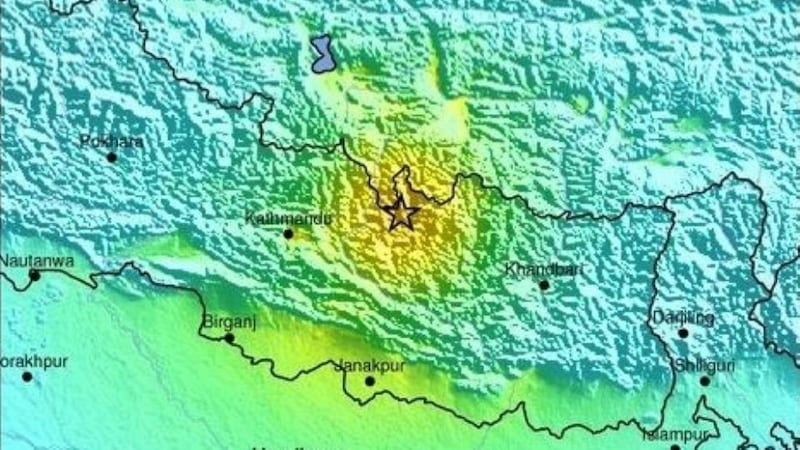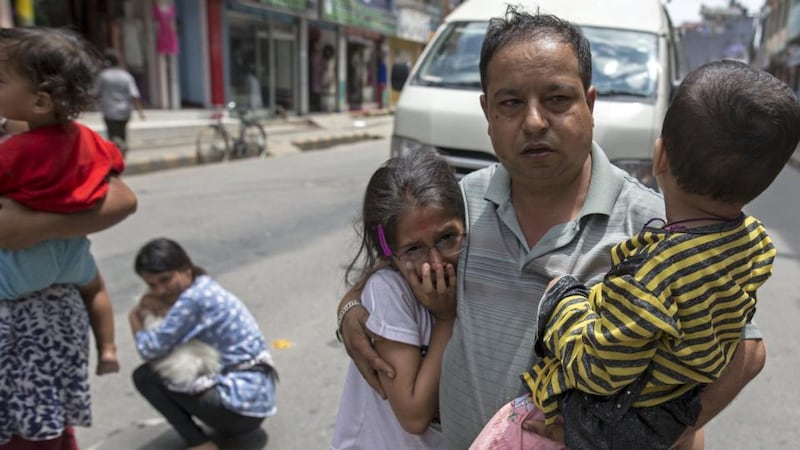A US marine corps helicopter involved in disaster relief efforts in Nepal has been declared missing while working in the vicinity of Charikot village, a spokesman for the US Pacific command said.
Army major David Eastburn said US military personnel were responding to the disappearance of the UH-1 Huey helicopter and that the incident was under investigation.
Six US Marines and two Nepalese soldiers were reportedly aboard the helicopter, which is one of three UH-1 Huey vehicles participating in earthquake relief operations in the area.


Charikot was one of the villages in Nepal hardest hit by today’s new 7.3-magnitude quake, the most powerful aftershock following April’s 7.8 magnitude quake.
The aircraft is part of marine light attack helicopter squadron 469.
The helicopter crew were overheard talking on the radio about fuel problems before the aircraft went missing, the Pentagon said.
Pentagon spokesman Steve Warren said US search flights have been suspended due to darkness but a ground search by Nepalese army troops in the rugged, mountainous area continued during the night.
“Essentially what we have right now is truly a missing helicopter. We simply don’t know its location,” Mr Warren said.
Mr Warren said it was not clear whether the helicopter might have been low on fuel or if there was a problem with its fuel lines.
“The UH-1 had launched to deliver tarps and rice,” Mr Warren said. “Because of the terrain [it] had not been in contact for approximately two hours. No emergency beacon has been detected at this time.”
Mr Warren said US air force pararescue forces had rehearsed and were available if needed.
A Nepalese air brigade reported seeing the US helicopter at a location some 65km east of the capital Kathmandu, but three aircraft sent to search the area did not spot it during the daylight hunt.
Nepal quake
The earthquake has killed at least 66 people so far, including 17 in neighbouring India and one in Tibet.
It spread panic in Nepal, bringing down buildings already weakened by a devastating tremor less than three weeks ago and unleashing landslides in Himalayan valleys near Mount Everest.
Most of the reported fatalities were in villages and towns east of capital Kathmandu that were only just beginning to pick up the pieces after the April 25th quake that left more than 8,000 people dead.
The new earthquake was centred 76km east of the capital in a hilly area close to the border with Tibet, according to coordinates provided by the US Geological Survey.
The survey said the earthquake was centred 68km west of the town of Namche Bazar, close to Mount Everest and the border with Tibet.
Villagers who watched their homes collapse in the earlier quake said they only survived this time because they were already living in tents.
Aid workers reported serious damage to some villages in the worst affected area, Charikot, and said some people were still trapped under rubble.
Witnesses said rocks and mud came crashing down remote hillsides lined with roads and small hamlets.
“We still don’t have a clear view of the scale of the problem,” said Dan Sermand, emergency coordinator at Médecins Sans Frontieres, which surveyed the area by air and saw multiple landslides.
GOAL’s country director in Nepal, Dr Raj Singh, described the scene on the ground in Kathmandu as “chaotic”.
“People are not permitted to enter buildings at the moment and we have had three aftershocks since the quake, one of which was very pronounced.”
The UN has only raised 13 per cent of the $423 million it said was needed to help Nepal recover from the April tragedy, and relief workers warned that even more funding would now be needed.
Charikot damage
In Charikot, where at least 20 bodies were recovered, hotel owner Top Thapa said the quake was at least as strong as last month.
“We saw houses falling, collapsing along the ridge,” said Mr Thapa, owner of Charikot Panorama Resort. He said he saw five or six multi-storey buildings come down.
Politicians dashed for the exit of Nepal’s parliament building in Kathmandu when the quake hit. People in the capital, panic-stricken after the April 25th quake, rushed outdoors, reporters said.
Parents clutched children tightly, and hundreds of people frantically tried to call relatives on mobile phones. Shopkeepers closed their stores and the streets were jammed with people rushing to check on families.
Elsewhere, people huddled in public spaces, too nervous to venture inside.
Office towers reportedly swayed as far away as New Delhi.
The tremors could also be felt in Bangladesh.
Four people died in Chautara in Sindhupalchowk district, north of the capital Kathmandu, after several buildings collapsed, a spokesman for the International Organisation for Migration said.
Separately, 300 people are reported injured in Sindhupalchowk, which suffered the heaviest death toll in last month’s quake. The new tremor also triggered at least three big landslides in the district.
“The latest earthquake has left us shaken. I am still trembling,” said the official, Diwakar Koirala.
In the town of Sangachowk, residents were outside receiving government food aid when the quake struck.
“It was really lucky. If we were inside, it would have been a lot worse,” said Purushottam Acharya (30).
A family sat on the edge of the road where their house had just fallen down the hill, with rubble spread over hundreds of feet below.
“We watched it go down slowly, slowly,” a family member said.
Residents in the Indian town of Siliguri, near the border with Nepal, said chunks of concrete fell off one or two buildings.
Meanwhile, new landslides blocked mountain roads in the district of Gorkha, one of the most damaged regions after the April 25th quake.
“People are terribly scared. Everyone ran out in the streets because they are afraid of being inside the houses,” Norwegian Red Cross secretary-general Asne Havnelid told Norwegian broadcaster NRK.
“I am very scared and I am with my two sons. The school building is cracked and bits of it, I can see they have collapsed,” said Rhita Doma Sherpa, a nurse with the Mountain Medicine Centre in Namche Bazaar, a departure point for trekkers headed to Everest.
“It was lunchtime. All the kids were outside. Thank god.”
Peak season
May is peak season for climbing and trekking in Nepal’s high altitude valleys and peaks, but the usually bustling lodges and tea-houses were close to empty after thousands of tourists fled the April quake.
Dambar Parajuli, president of Expedition Operators’ Association of Nepal, said there were no climbers or Nepali sherpa guides at Everest base camp.
Mountaineers seeking to scale the world’s tallest peak called off this year’s Everest season after 18 people died when last month’s quake triggered avalanches on the mountain.
“All of them have already left,” Mr Parajuli said.
In Lukla, the official departure point for treks to Everest, buildings cracked and small landslides were triggered when the ground shook. At least three school children were injured.
Susana Perez from Madrid was on a 10-day trek with her husband to Island Peak in the Everest region and was about to reach Lukla.
“We saw the mountain in front of us fall down - earth and rocks. There were some houses underneath but it was not clear if they were hit,” Ms Perez said.
Aftermath
In Nepal, the quake left 1,176 injured, and 48 dead, police spokesman Kamal Singh Bam said.
Seventeen people were killed in the Indian states of Bihar and Uttar Pradesh, India’s home ministry said in a statement. Chinese media reported that one person died in Tibet after rocks fell on a car.
Indian and US military aircraft have already flown more than 60 wounded people to Kathmandu from affected areas.
Nepal had barely begun to recover from the devastation caused by last month’s 7.8-magnitude earthquake, the country’s worst in more than 80 years, which killed at least 8,046 people and injured more than 17,800.
The impoverished country has appealed for billions of euros in aid from foreign nations, as well as medical experts to treat the wounded and helicopters to ferry food and temporary shelters to hundreds of thousands left homeless amid unseasonal rains.
Some foreign rescue teams had returned home from Nepal, but may need to be pressed into service again.
Wojtek Wilk, CEO of the Polish Centre for International Aid, said the new quake presented a funding challenge.
Last week, World Food Programme head Ertharin Cousin said that the scale and number of global humanitarian crises was straining donors.
Reuters







